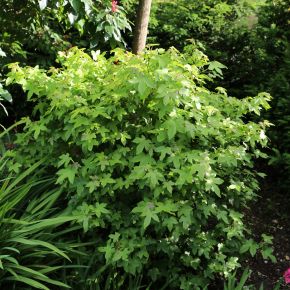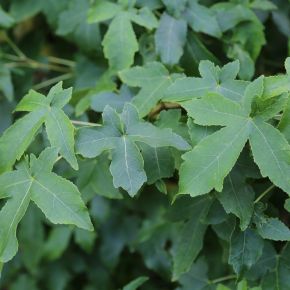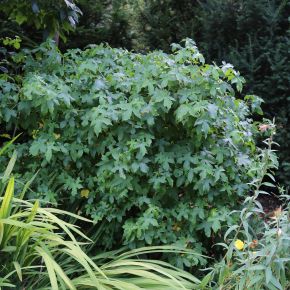Liquidambar styraciflua 'Gum Ball'
(Sweet Gum 'Gum Ball')
Family - Hamamelidaceae
Category - Tree
Origin - Discovered in Tennessee, USA
Discovered By - Introduced by Mr Hiram Stubblefield
Year of Introduction - 1965
Season of Interest - Spring, Summer, Autumn, Winter
Hardiness - H6
Height - 5m
Width - 4m
Description: Large Deciduous Shrub or small tree with a rounded outline, and attractive, mid-green leaves that are palmately lobed. The leaves are retained on the plant for a long time, and will generally not show any 'autumn' colour until winter. The foliage will turn shades of red, orange and purple before finally falling. Male and female flowers are produced separately, but on the same plant (monoecious) in late spring. However, flowers or fruit are not often observed on this particular variety in this country. When produced, both male and female flowers are small and green, and not considered to be of great visual impact. The female flowers are followed by round, brown, spiky seed Capsules. Liquidambar styraciflua 'Gum Ball' is slow growing.
'Gum Ball' was discovered by the nurseryman, Hiram Stubblefield, former owner of the now-closed Forest Nursery.
Synonym- Liquidambar styraciflua 'Globe'
Flower:
Monoecious. Flowers and fruit are not often observed in this country, and if produced, the flowers are not visually significant. Small, green male flowers composed of many stamens are held in dense racemes. Green female flowers are held in globular heads and are followed by brown, round spiky seed capsules that persist on the plant long after the seeds have been released. Flowers are produced May.
Flower colour: Green
Flower shape: Flowers in racemes or globular heads
Flowering time: May
Foliage:
Glossy, mid-green leaves are palmately lobed, usually with five to seven lobes, and have finely serrated margins. Leaves are Alternately arranged and retained on the branches into winter. The leaves turn shades of red, orange and purple before finally falling.
Foliage Senescence: Deciduous
Foliage Shape: Palmately lobed
Autumn Colour: Red, orange, purple
Propagation:
Cuttings, grafting.
Cultivation:
Best in full sun to partial shade in moisture-retentive, but well-drained soil. (The autumn colour is more pronounced when planted in a sunny position.) Prefers a rich, deep soil that has a neutral to acidic pH, but will tolerate some lime. Not suitable for shallow chalk soils.


